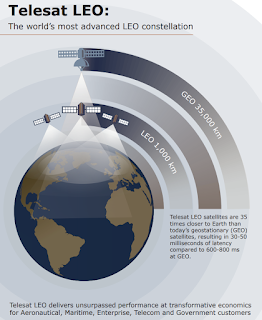Telesat LEO as Starlink competitor?
Does Telesat LEO constellation stand a chance? In my opinion, no. Not even close. But I will elaborate.
Telesat announced its LEO constellation back in 2017, with a single Phase 1 testing satellite launched in January 2018. They initially announced Phase 2 launch in 2020 and entry into service in 2021. But since then whole project moved slowly. Now they plan to announce selection of 300 satellite vendor this summer, with launch date in 2022 and entry into service in 2023. At the time Starlink will have thousands satellites in orbit. And hundreds of thousands terminals deployed. And software working.
Of course, Telesat emphasizes that they are different. They have 4 GHz license in Ka-band. While Starlink will initially use less than 1 GHz u Ku-band. They announced use of inter-satellite links. Which will not be present in the first generation of Starlink satellites. They will use higher orbit, enabling twice the distance between gateway and ground terminals. And they will target polar and highly inclined orbits first. Which is not Starlink primary target.
This snippet from Telesat web site puts some bold claims. Most advanced? Maybe. But there is a big BUT. Their satellites will have 800 kg of weight, and with 300 satellites and 4GHz bandwidth they will reach 10THz of capacity. That is around 2500 beams or roughly 8 beams per satellite. Not that great. And they need to lift 240 metric tones to highly inclined LEO orbit. Who will launch it? Blue Origin. That is around eight to nine launches of New Glenn. How much that will cost? A billion USD? Ok, maybe they will get a discount as an early customer.
And how long will it take New Glenn to perform nine missions? It took Falcon 9 four years. For Atlas V, it was five years. For Delta IV, it was seven years. But Blue Origin should make it in one year. Despite the fact that it took them 18 years and they still haven't launched one orbital rocket. Any how many New Glenn initial missions will be for the Telesat? Half? So Telesat might get operational in 2025. Maybe even later. Unless they switch to ULA or SpaceX.
It gets worse. For SpaceX, the equivalent constellation would take 15 launches. It would take less than a year. 900 satellites. Maybe a little bit less due to highly inclined orbits. But still, SpaceX can launch an effective competition for less than 500 million. And the same satellites can also provide bandwidth to existing users closer to equatorial belt.
Note that the contract value for manufacturing has been estimated at 3 billion USD. That seems excessive. Unsustainable. SpaceX can launch over 3000 satellites and over 50TBit/s capacity for this money.
But what about inter-satellite links, you say? What about deploying a simple set of relay terminals in the Arctic? They could be used instead of inter-satellite links. It is cheap and easy. If only they could use solar panels and batteries. Long polar nights are a bit of an issue there. But still, how much power is really required for a relay? 100W? They have 100kWh battery packs from Tesla. For roughly 10000USD per pack that leads to 20 day autonomy in complete darkness. Heating of battery would probably use more power than powering the user terminal. Probably vacuum insulation would cost more than a battery. And it would be an interesting exercise for SpaceX designers. If they cannot design battery insulation to survive long polar nights, what are they going to do on the Mars and the Moon? Burn methane? Then again, liquid methane contains 6kWh of thermal energy per liter.
But I digress. Essentially, Telesat has no intrinsic advantage compared to Starlink. Although it is not targeting individual/residential subscribers, it is obvious that Starlink focus on low hanging fruit. Residential/rural subscribers will be much more profitable than telecom/back-haul/industry/aviation customers in the short run. But Starlink can easily undercut the pricing for Telesat LEO. Just the cost of launch for Telesat is much higher than complete Starlink cost for polar regions. And Starlink will have low-cost terminals developed. So both on ground and space segments Telesat will be at least twice as expensive.
There is another BUT, and that is interest from Canadian government to provide broadband connectivity. That has been materialized through initial funding of 85 million CAD and additional funding commitment of almost 600 million CAD spread over 10 years. Seems like much, but FCC RDOF will invest almost 16 billion USD over the same period. And major portion of that will go to SpaceX.
So Telesat is in limbo. Canadian government will demand to finish the constellation to provide the development funds. They also have 4 GHz Ka-band priority license. OneWeb, a potential competitor which also targeted polar regions is in bankruptcy. SpaceX can put a crushing competition in less than a year. Let us not forget SES Networks. Although their mPOWER constellation will initially cover equatorial regions, they have requested allocations for inclined orbits that can easily reach polar regions. That would avoid a need for having ground stations/gateways on high latitude. Also low number of MEO satellites required limits SpaceX advantage.
So the best course of action is to delay and wait. Blame COVID-19, just like OneWeb. And then, if Starlink enters service over polar regions, throw in the towel. If selection of the space segment manufacturer is further delayed from this summer, we might assume that Telesat LEO project is dead.


Comments
Post a Comment